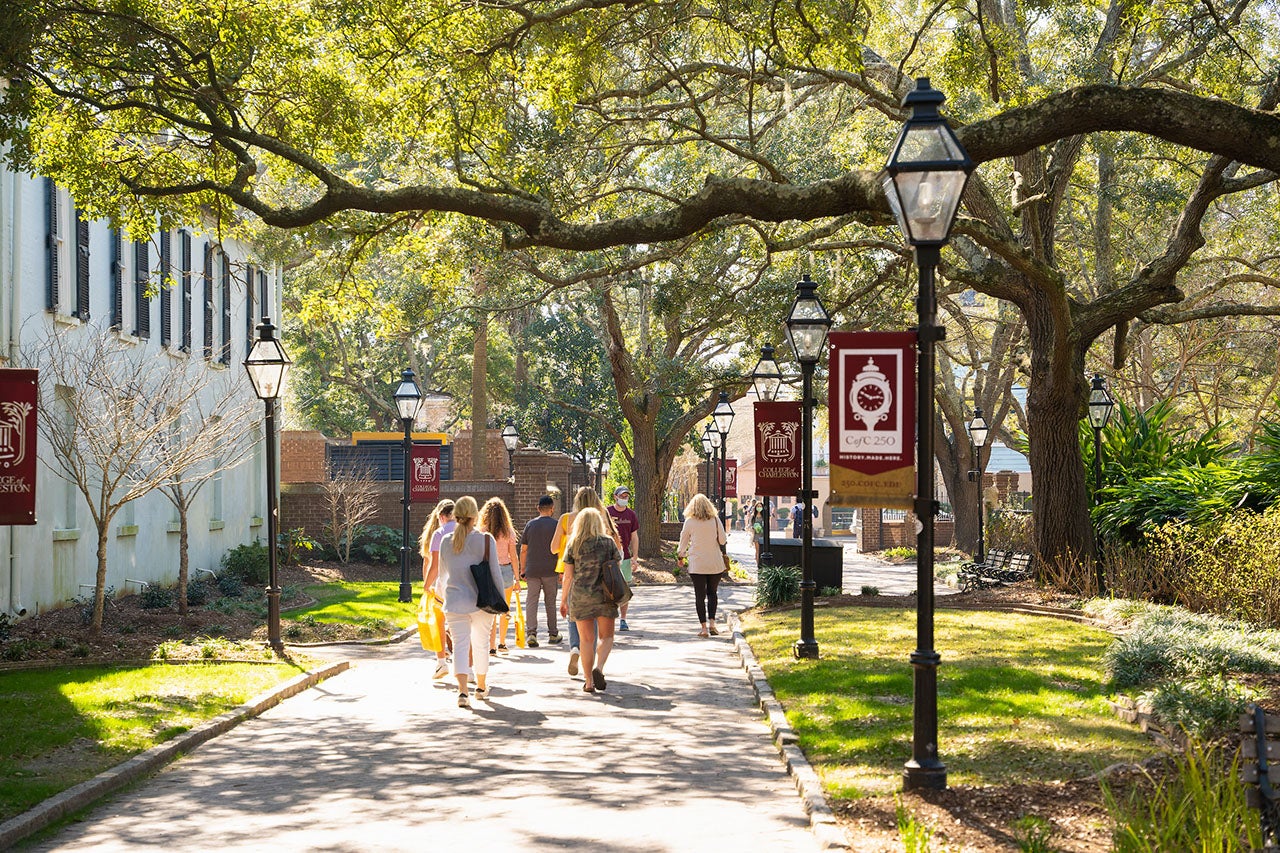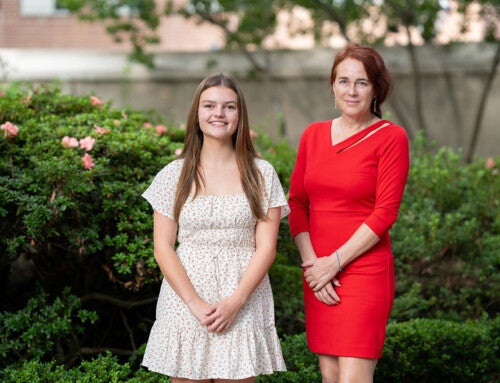The year 2020 was expected to be a monumental one for the College of Charleston. And it was, but not in the way school leaders had hoped.
With 2020 marking the 250th anniversary of the College’s founding in 1770, the school had spent months planning for a year-long celebration of the milestone. Events were scheduled, speakers booked and special programs readied for launch.
But within weeks of kicking off the anniversary year with a special event in Cistern Yard in January 2020, the sudden emergence of COVID-19 changed everything. The global pandemic forced the College to pause the anniversary plans and turn its focus toward a sudden pivot from in-person learning to a blend of asynchronous and synchronous online learning.
Unlike some colleges and universities that completely halted in-person classes for most of the 2020-21 school year, the College was able to offer a blend of in-person, online and hybrid classes starting with the fall 2020 semester and increasing into the spring of 2021. The key to offering in-person classes was strict adherence to and enforcement of the school’s COVID-19 mitigation plan, which included testing and vaccination clinics, messaging campaigns and code of conduct referrals.
But a healthy campus was not College of Charleston President Andrew T. Hsu’s only concern. At the start of the pandemic, he vowed to prevent any staff and faculty layoffs during the year. He was able to keep that promise. The College carefully managed its finances throughout the pandemic and implemented temporary spending controls that helped the institution avoid mandatory furloughs and layoffs of employees. It was one of the few schools in South Carolina to accomplish that goal.

Students attend a hybrid genetics lab during the fall 2020 semester, taught both online and in person by biology Professor Agnes Ayme-Southgate. (Photo by Mike Ledford)
Moving Forward
In planning for the Fall 2020 semester, President Hsu and his leadership team knew they had to strike a balance between keeping students, faculty and staff safe while also continuing to deliver a high-quality education. They decided that offering a reduced number of in-person classes with strict guidelines for face masks and social distancing would be the best way to navigate the academic year.
“I knew that our talented faculty would be able to deliver a quality education in these online formats, but I also knew that both students and their families needed to be reassured that online learning would be just as meaningful as in-person learning,” says Hsu. “The best way to convince them was to show them.”
Suzanne Austin, executive vice president for academic affairs and provost, assembled a group of faculty to hold a live-panel discussion to educate students and families about the different types of class formats and how professors approach teaching in each modality. The professors also offered tips for students to be successful in the virtual environment. The initiative was a success with hundreds of people viewing the panel live or in a recorded format. The College’s news and social media accounts were also used to drive home the benefits of online learning.
The pandemic introduced new challenges for the college, especially assisting students and employees with the transition to remote learning and working. To make sure that all students had the technology needed to move forward, the College’s Division of Information Technology offered equipment on loan to students. During the pandemic, the division provided more than 275 laptops and 61 WIFI hotspots to help students stay connected. The division also implemented a virtual desktop solution to enable students and faculty to access software from anywhere on their personal devices, rapidly implemented Zoom and LinkedIn Learning options, published daily tech tips for employees, and facilitated the use of virtual phones to create a transparent experience for the campus community.
“Many of these changes have become part of ‘what we do’ that will go well beyond the pandemic and the return to normal,” says Chief Information Officer Mark Staples. “While the virtual world is not a replacement for personal engagements, the convenience to be able to connect with students and our colleagues changes the way we think about service.”
Virtual Town Halls
It was clear to Hsu and his administration that the best way to keep the campus community informed of the ever-changing academic landscape was to maintain constant contact with families and students during the school year. They knew students and their families had questions and concerns, and everyone needed assurance that the College would remain safe while maintaining its reputation for rigorous academic instruction and student life offerings.
With that in mind, Hsu and his senior staff held a series of virtual town hall meetings for over a year. In all, 21 rounds of live town hall meetings, including separate town halls for employees and students and families, were conducted from March 2020 through April 2021. Hsu and his COVID-19 leadership team attended each meeting and addressed a total of nearly 1,400 questions throughout the year. More than 26,000 parents, family members, students, faculty and staff participated in the town halls, all of which were recorded and made available on the College’s COVID-19 website, Back on the Bricks.
“I think it was important that the families and students knew that someone was available to answer their questions,” says Hsu. “Not only did it help the families and students understand what was going on at CofC, but it also helped us to understand their concerns so that we could adjust our planning as necessary.”
Student Success
The personal and frequent engagement from faculty and the administration translated into a better educational experience for students, and the final grades proved it. At the end of the 2020-2021 school year, the average GPA for CofC students rose to 3.20, up from the 3.10 at the start of the 2019-20 school year.

Finance professor Jocelyn Evans embraced online instruction with her course Financial Literacy for Generation Z offered via Zoom.
“Our faculty truly embraced online learning,” says Austin. “They innovated and engaged with their students in new and meaningful ways. Many faculty members said their connections with students were actually deepened in the virtual environment and felt the experience made them better teachers.”
Perhaps more than any other group, on-campus residential students were significantly impacted by the pandemic. Alicia Caudill, executive vice president for student affairs, says the College was able to allow students in the residence halls by reducing density and establishing guidelines such as closing common areas and limiting visits.
“We knew these restrictions were difficult for our residential students, but they allowed us to still offer the on-campus living experience that is such an important part of college life,” says Caudill. “I’m so proud of our resident assistants and our professional staff for coming up with creative ways to keep our on-campus students engaged through virtual events, regular check-ins and fun activities.”

Maroon Monday was among the many activities hosted by student affairs during the 2020-21 academic year. (Photo by Heather Moran)
Caudill says with creative work and dedication, the College was able to offer many ways for students to engage while still adhering to COVID safety guidelines. In all, student affairs offered more than 200 programs and events for students during the 2020-21 academic year.
As the end of an unprecedented and historic academic year wound down this spring, the College ensured that the pandemic would not take away from the celebration of its graduating seniors. For the first time ever, the College offered seniors a choice in graduation ceremonies. Due to social distancing requirements for large gatherings, students were offered a traditional commencement ceremony in the College’s historic Cistern Yard without guests or they could choose to attend a ceremony at the College’s soccer stadium and bring up to four guests.

Prospective students and their parents tour the campus during the spring 2021 semester. (Photo by Mike Ledford)
Connecting With New Students
As College faculty and staff worked hard to help current students maintain their academic progress, the school’s admissions side was employing unique methods to engage with prospective students and families. Like their peers at many other midsized schools, CofC recruiters knew that they had to be creative in connecting with prospective students during a time when job fairs and high school campus visits were not an option.
“We knew that we had to readjust our recruitment to students during the pandemic and wanted to be as creative as possible to meet their needs,” says Amy Takayama-Perez, vice president for university marketing and enrollment planning.
Among other tactics, the admissions team offered 851 virtual high school visits, 68 college fairs, 43 virtual events, as well as 120 virtual information sessions with nearly 60,000 visitors to the virtual tour this year.
The College also hosted over 10,800 on-campus visitors since safely re-opening tours in August 2020.
Takayama-Perez says it was important for prospective students and families taking on-campus tours to not only see the school in person, but to also see the College’s health and safety protocols in action. The approach worked, and the College set a new record for interest, with more than 20,000 applications for fall 2021. The incoming freshman class is expected to increase by 400 students over the previous fall.
Looking Ahead
In addition to the 250th anniversary, 2020 was also highly anticipated because the College planned to complete a strategic planning process and submit the plan to the school’s Board of Trustees for approval. Despite the many challenges brought on by the pandemic, including the pivot to remote work and virtual meetings, Hsu was determined that the College push ahead with readying the plan. By keeping the College and its leadership team focused on strategic priorities and long-term planning in the midst of a global pandemic, Hsu successfully secured approval of the plan by the trustees in May 2020. The College then held a virtual campus forum in February 2021 to formally kick off the plan’s implementation.
“It would have been easy to pause our work on the Strategic Plan and to blame the pandemic,” says Hsu. “But I had confidence that our senior leadership team, our deans and our entire campus community would be able to navigate the pandemic while maintaining progress toward our long-term goals.”
And with continual evidence that the pandemic is easing in the U.S., the College is now primed for a re-emergence as it prepares to welcome students back to campus for a new academic year in August 2021.





